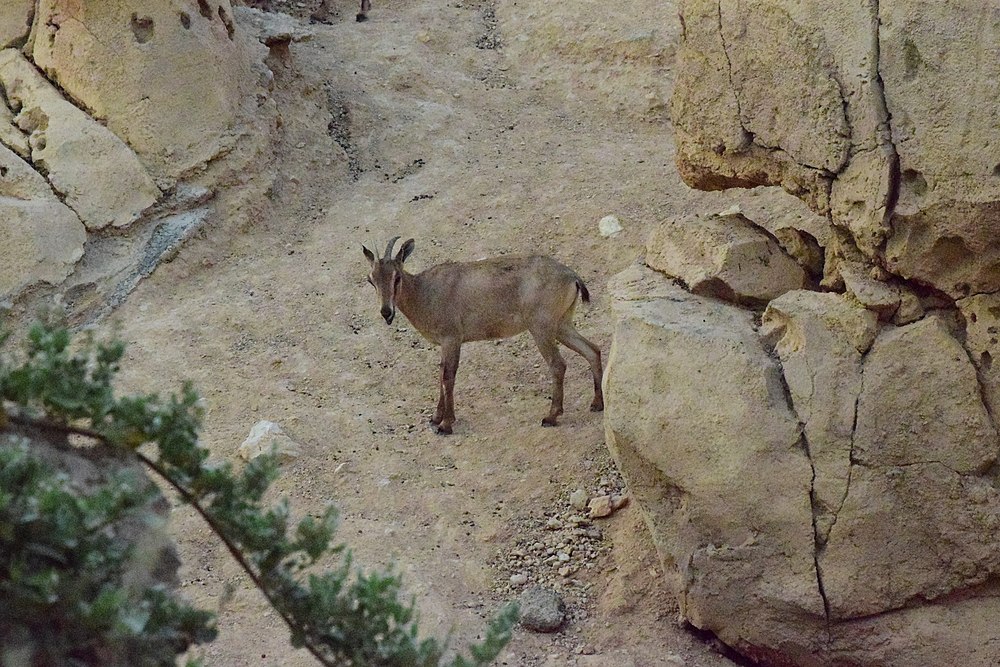Arabian tahr
| Arabian tahr | |
|---|---|
| Tahr at Al Ain Zoo near Jebel Hafeet in the UAE | |
| Scientific classification | |
| Domain: | Eukaryota |
| Kingdom: | Animalia |
| Phylum: | Chordata |
| Class: | Mammalia |
| Order: | Artiodactyla |
| Family: | Bovidae |
| Subfamily: | Caprinae |
| Tribe: | Caprini
|
| Genus: | Arabitragus Ropiquet & Hassanin, 2005 |
| Species: | A. jayakari
|
| Binomial name | |
| Arabitragus jayakari (Thomas, 1894)
| |

| |
| Distribution of the tahr in the region of the Hajar Mountains of Oman and the UAE in Eastern Arabia | |
| Synonyms | |
|
Hemitragus jayakari | |
The Arabian tahr (Arabitragus jayakari) is a
Description
It is the smallest species of tahr. It is of stocky build with backward-arching
As of a 2018, the wild population is thought to comprise around 2,200 individuals.[1]
Habitat and range
The Arabian tahr lives on steep rocky slopes of the Hajar Mountains in Oman and the United Arab Emirates, at altitudes up to 1,800 m (5,900 ft) above sea level. It is also found in the area of Jebel Hafeet.[2][3][4]
Taxonomy

The Arabian thar was first described in 1894 by Oldfield Thomas who proposed the name Hemitragus jayakari for zoological specimens collected in Oman Jebel Taw.[6] It was separated into the newly created genus Arabitragus in 2005 on the basis of a study on the molecular phylogeny of the group.[7]
Etymology
The genus name Arabitragus is derived from the Greek words aravikós meaning "Arabian" and trágos meaning "goat".[8][9]
Behaviour and ecology
Unlike other species of tahr, the Arabian tahr is solitary or lives in small groups consisting of a female and a kid, or a male. Instead of forming herds during seasonal ruts, reproduction occurs in small, dispersed family units. Births have been reported as occurring throughout the year, and gestation lasts from 140–145 days.[citation needed]
Diet and predation
These animals are usually
The tahr was likely preyed upon by the
Threats
The Arabian tahr is endangered due to intense
Conservation
In 1973, efforts were planned to protect the Arabian tahr, and in 1975, it was granted in the Hajar Mountains. In 1980, a captive-breeding program was set up at the Omani Mammal Breeding Center to reintroduce captive-bred individuals back into the wild. Three institutions are now involved, one in Oman and two in the United Arab Emirates, but many people seem to be unaware about the tahr's grave situations, leading to other conservation initiatives to focus on the publicity and educational campaigns to raise the animals' profile. In April 2009, the Wadi Wurayah preserve in the Emirate of Fujairah was set aside by royal decree in the Emirates for the protection of the tahr.[4][11] Another place in the UAE, Sir Bani Yas in the Emirate of Abu Dhabi, was also set up for its conservation.[4][12]
See also
References
- ^ . Retrieved 18 February 2022.
- The Gulf Today. Archived from the originalon 2018-03-30. Retrieved 2018-03-30.
- ^ De Leon, J. P. (2014-05-26). "100th Arabian tahr, and twin tahrs welcomed in Al Ain". Gulf News. Retrieved 2018-04-03.
- ^ a b c "Newborn Arabian tahr discovered on Jebel Hafeet". The National. 2015-03-12. Retrieved 2018-03-30.
- ^ Smit, J. (1894). "Hemitragus jayakari". Proceedings of the Zoological Society of London (May): 534.
- ^ Thomas, O. (1894). "On some specimens of mammals from Oman, S.E.Arabia". Proceedings of the Zoological Society of London (May): 448–455.
- PMID 15904863.
- ^ Liddell, H. G.; Scott, R. (1940). "ραβία". A Greek–English Lexicon (Ninth ed.). Oxford: Clarendon Press.
- ^ Liddell, H. G.; Scott, R. (1940). "τράγος". A Greek–English Lexicon (Ninth ed.). Oxford: Clarendon Press.
- ^ a b Edmonds, J.-A.; Budd, K. J.; Al Midfa, A. & Gross, C. (2006). "Status of the Arabian Leopard in United Arab Emirates" (PDF). Cat News (Special Issue 1): 33–39.
- ^ "Arabian Tahr gets royal protection". WWF. 2009. Archived from the original on 2018-09-13. Retrieved 2018-03-30.
- ^ "Endangered Arabian tahr born on Sir Bani Yas Island". Gulf News. 2018. Retrieved 2018-04-02.
External links
![]() Media related to Arabitragus jayakari at Wikimedia Commons
Media related to Arabitragus jayakari at Wikimedia Commons


